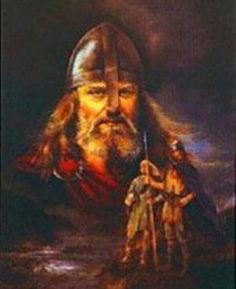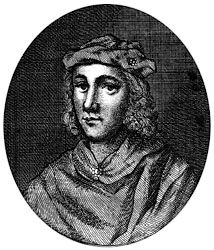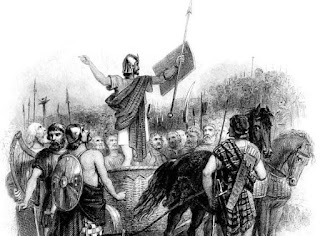Divide & Conquer (Part 2)
Edward & Toom Tabard
He used his legal status as the superior lord to claim the revenues collected from vacant estates and various offices. Having been acknowledged by all the would be kings, he was able to back date access to all royal money to the death of Alexander III.
When Balliol acquired the Scottish throne, he found the kingdom owed Edward six years' worth of revenues and there was a large personal debt from his own estate. Indeed, most Scottish revenues were finding their way south, giving John very little room to manoeuvre.
Edward continued to force the issue, summoning John to fight with him and ordering him to appear at Westminster to justify his court's decisions. By 1295 the situation had become intolerable for Balliol. For almost 130 years, Scots had had no serious conflict with England, but their next move would lead to decades of bitter, bloody fighting.
They signed a treaty with France, which was in effect the birth of the Auld Alliance and the start of the Wars of Independence.
Edward's response was to march on Berwick, then one of the most important towns in Scotland, and carry out a sickening slaughter. Of the town's 12,000 inhabitants in those days, only about 5,000 survived the carnage.
At the Battle of Dunbar Balliol's forces were vanquished by a combination of Edward's army, Bruce's troops, and the forces of other Scottish nobles. It was all too much for King John. He gave up his crown and begged mercy from the English King. After spending three years in the Tower of London, he retired to family estates in France, where he died in exile.
But if ever a politician needed a good PR job, it was John Balliol. Not only does he have to contend with the dismissive nickname of "Toom Tabard' or Empty Coat, but he is rarely even accorded his title of king. There is little doubt that King John was the subject of a systematic campaign to blacken his reputation, and even write him out of history, conducted not by the English but by the man who eventually usurped his throne – Robert Bruce.
We may never know much about Balliol's reign or his personality, and what information we do have at our disposal should be treated carefully, in case it has come down to us through the distorting lens of Bruce propaganda.
Balliol came from Northumberland where his paternal family had extensive lands centred on Barnard Castle. The Balliols originated in northern France where they still had estates. John was far less a Scotsman than an Englishman, but he was not unusual in maintaining considerable interests north of the Border.
We should also remember that his mother, Devorguilla, was from Celtic stock. As senior heiress of the Lords of Galloway, she had brought her husband, another John Balliol, both the ancient Celtic title and substantial lands and property, including the castle at Buittle near Kirkcudbright. The elder John was presumably a cultured man and had endowed the Oxford college bearing his name.
Contrary to later suggestions of spinelessness, Balliol was quick to assert his belief that he was the rightful king. He had powerful supporters, including William Fraser, bishop of St Andrews, and, more importantly, his in-laws, the Comyns, Scotland's leading family. Balliol designated himself 'heir of Scotland'.
Within purely domestic matters, he showed himself willing and able to provide firm leadership - legislating, for example, for the administration of the newly-acquired Western Isles (bought from Norway in 1266). The story goes, of course, that the Scottish nobility, tired of their king's inability to stand up to Edward, took power away from John, appointed a number of Guardians and negotiated a treaty with France as a prelude to war with England. But that makes little sense considering the relationship between the king and his in-laws, the Comyns, leaders of the Scottish nobility.
Balliol relied on them as the backbone of his political support in Scotland, in the same way as Bruce relied on James the Steward and the earl of Atholl. There was therefore little need for them to remove the king from power. Equally, King John's active role in pursuing the treaty with France is surely witnessed by the fact that certain Balliol lands in France were to be given as dowry to the King of France's niece, who was to marry his son, Edward. One of the ambassadors to France, Sir John Soules, was the same man whom Balliol later appointed as his own particular Guardian in Scotland after he was forced into exile.
It's hard to separate fact from fiction in these events, since the only descriptions of them come from sources generally hostile to King John, either English or pro-Bruce.
Balliol was clearly not much of a military man he relied on the Comyns and other members of the nobility to lead the army against Edward. However, he paid the price after the Scottish defeat at Dunbar
It's hard to separate fact from fiction in these events, since the only descriptions of them come from sources typically hostile to King John, either English or pro-Bruce. However, he paid the price after the Scottish defeat at Dunbar, when he was humiliatingly stripped of his kingship at Stracathro churchyard near Brechin.
For the next few years, he and his son were lodged in the Tower of London until successful Scottish diplomacy secured John's release (but not that of his heir) into Papal custody.
The Scots, who had certainly not ditched their king but were instead fighting any way they could to get him back, then succeeded in having him completely set free. Balliol made his way to France, trying to persuade the French king to provide support – money and troops – for an invasion. Just as even Edward admitted that King John's return was likely, the European diplomatic scene changed in Edward's favour. Both France and the Pope needed his help, and the Scots were ditched.
Can we blame King John for remaining in France? What would have been the point in his arrival in Scotland without an army, rather like Bonnie Prince Charlie 450 years later?
Perhaps he can be blamed for absolving the French king of his promise to help the Scots, but this was a man in exile reliant on him.
Balliol died there in 1313. For the last seven years of his life, he had watched events in Scotland change dramatically. Although the Scots had accepted Edward I as their ruler in 1304, the seizure of the throne by Robert Bruce in 1306 must have been a bitter blow.
The fact that so many saw King John as the rightful king explains the support given to Edward Balliol when he invaded Scotland in the 1330s, even though the might of Edward III of England stood behind him.
King John will never emerge from the murky shadows of history as a great figure, but there is no denying that he did his best against a formidable adversary – Edward I.
Balliol was also the man for whom so many Scots, including William Wallace, fought and died.











Comments
Post a Comment